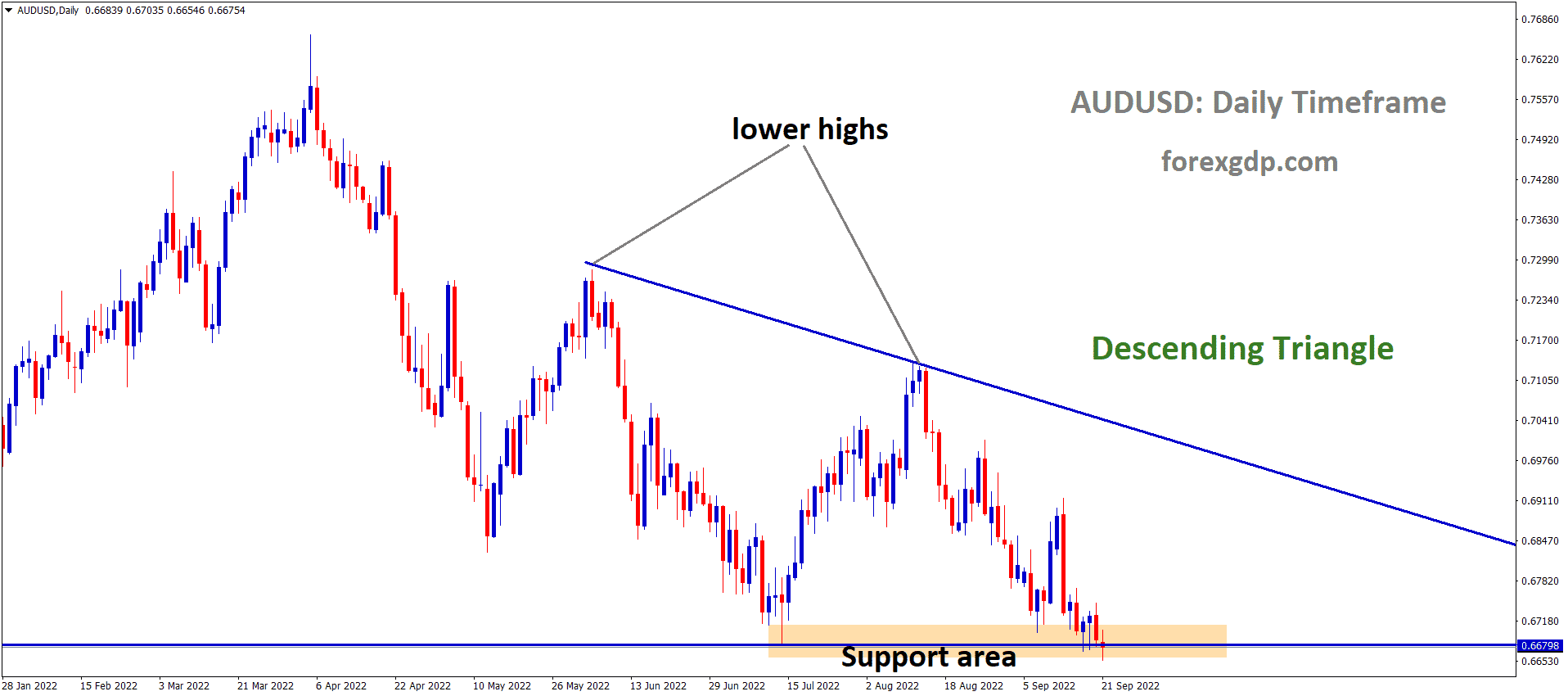USDJPY has broken the uptrend channel on the downside
Daily Forex Trade Setups July 21, 2025
Stay on top of market trends with our Daily Forex Trade Setups (July 21, 2025)
USDJPY Struggles as Yen Gains Ground but Bulls Stay Cautious
The Japanese Yen (JPY), known for being a safe-haven currency, isn’t acting like one right now. Usually, when there’s global uncertainty or financial turbulence, investors rush to the Yen. But lately, that hasn’t been the case. On a recent Monday, the Yen opened slightly stronger, but it couldn’t hold onto the gains for long. So, what’s pulling it back?
There are a few key reasons the Yen is having a tough time. Let’s break them down in a simple and relatable way.
Political Shifts in Japan: A Setback for the Yen
A Tough Election for the Ruling Coalition
Over the weekend, Japan held elections for its upper house of parliament. The results? Not great for Prime Minister Kishida’s ruling coalition, made up of the Liberal Democratic Party (LDP) and its partner Komeito. They failed to secure a majority, following another major loss in the lower house last year.
This isn’t just a political headline—it’s a signal to the financial world that Japan may face difficulties getting policies passed in the near future. And when political power is divided or weakened, economic reform gets put on the back burner. Investors start to worry, and in this case, they’re not feeling confident about holding onto Japanese assets.
What This Means for the Economy
The loss in the upper house could mean slower action on key financial policies. There’s pressure from the opposition to increase government spending and cut taxes. While that might sound like good news for the public, it raises big concerns about national debt and fiscal responsibility.
At the same time, Japan is in the middle of sensitive trade negotiations with the U.S. With a key deadline looming, uncertainty about how Japan will respond has only increased. If Japan can’t come to an agreement, it risks facing hefty tariffs from the U.S. on its exports—particularly on major industries like automotive and electronics. That adds more pressure to an already fragile economy.
The Bank of Japan’s Dilemma: To Hike or Not to Hike
One of the big questions investors are asking is whether the Bank of Japan (BoJ) will raise interest rates anytime soon. And honestly? It’s looking unlikely.

Why the BoJ Might Stay Put
Japan’s economy isn’t showing strong signs of growth. In fact, things seem to be slowing down. Real wages are falling, inflation is cooling, and consumer spending remains soft. Normally, central banks raise interest rates when inflation is hot—but Japan isn’t facing that kind of problem right now.
On top of that, political uncertainty usually causes central banks to tread carefully. So even if the BoJ was considering a rate hike, the election outcome makes it even less likely they’ll move aggressively. Investors are picking up on this hesitation, and it’s weakening the Yen even further.
Global Markets and the Dollar Tug-of-War
While Japan’s internal situation is one side of the coin, the global picture also plays a big role in the Yen’s recent performance—especially when it comes to the U.S. Dollar.
Mixed Signals from the Federal Reserve
The U.S. Dollar hasn’t been particularly strong either. It’s been floating below last month’s highs, partly due to uncertain messaging from the Federal Reserve (Fed). On one hand, Fed officials have made dovish comments recently, suggesting they might cut interest rates. On the other hand, inflation in the U.S. remains stubborn, which could convince the Fed to hold off on any cuts.
That kind of mixed message keeps traders guessing. And when the Dollar isn’t showing clear direction, the Yen usually has a chance to shine. But not this time.
Why the Yen Isn’t Winning
Even with uncertainty in the U.S. and globally, investors are hesitant to back the Yen. Why? Because Japan’s economic and political problems seem more concerning than what’s happening in the U.S. right now. And with the BoJ showing no urgency to raise rates, the Yen doesn’t look appealing as a safe-haven option.
So instead of turning to the Yen, investors are simply staying on the sidelines or looking for other places to park their money.
What’s Ahead for the Japanese Yen?
At the moment, there’s no clear catalyst to boost the Yen. With Japan’s markets closed for Marine Day and no major economic reports coming from the U.S., currency traders are just watching and waiting. Later this week, global PMI (Purchasing Managers’ Index) data might give us a glimpse into the health of major economies. If those numbers disappoint, we might see some volatility—but whether that helps the Yen is uncertain.
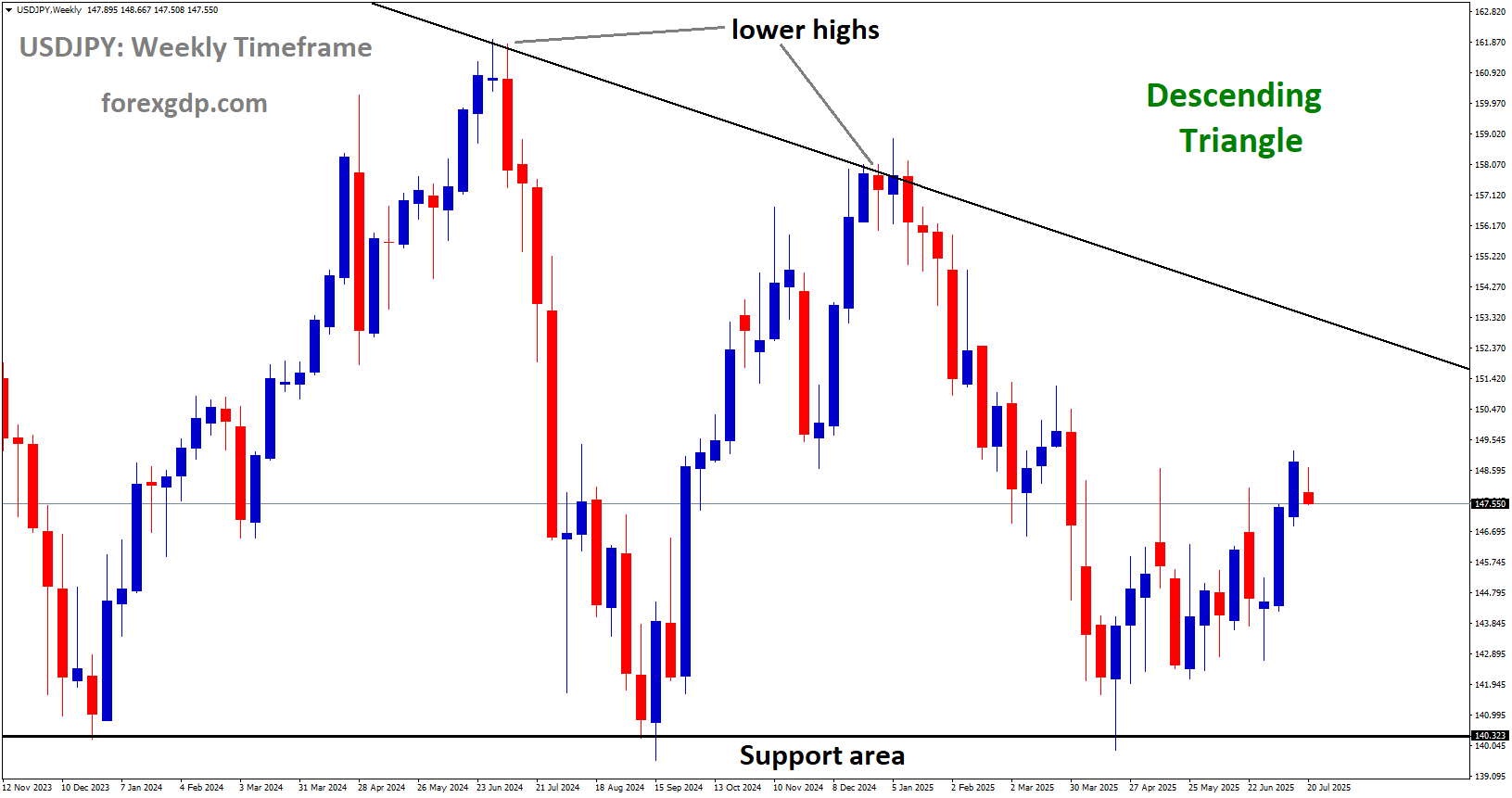
USDJPY is moving in a descending triangle pattern
In the meantime, the USD/JPY pair remains sensitive to shifts in global risk appetite. Any sudden shocks could push traders back toward safe assets, but the Yen will need stronger domestic fundamentals to really benefit from that.
Final Summary
The Japanese Yen is in a tough spot right now. It’s facing pressure from multiple directions—political uncertainty at home, cautious moves from the Bank of Japan, and an unclear global economic outlook. While it usually shines during times of global stress, this time it’s struggling to live up to its reputation.
Investors are watching closely, but without strong leadership, clear economic direction, or a proactive central bank, the Yen might remain on the back foot. That doesn’t mean it won’t bounce back, but for now, it’s more of a waiting game than a rallying cry.
If you’re someone who follows the currency market, the next few weeks could be crucial. Keep an eye on global data releases and any shifts in central bank policy. But don’t expect the Yen to take the lead unless something significant changes—either at home or abroad.
EURUSD Moves Up Cautiously with US-EU Tariff Drama Ahead
If you’ve been watching the financial news or scrolling through your favorite economic updates lately, you might’ve noticed the buzz around the Euro and what’s coming up on August 1. Let’s break it down simply: there’s a tariff standoff brewing between the United States and the European Union, and it’s making investors a bit edgy.
The Euro started the week on a slightly stronger note, but let’s not get too excited. That small uptick doesn’t mean smooth sailing ahead. The big deal here is what happens with trade negotiations over the next few days. Investors are hopeful—but cautious. This isn’t the first time tariff talks have made waves, and with the deadline inching closer, nerves are understandably frayed.
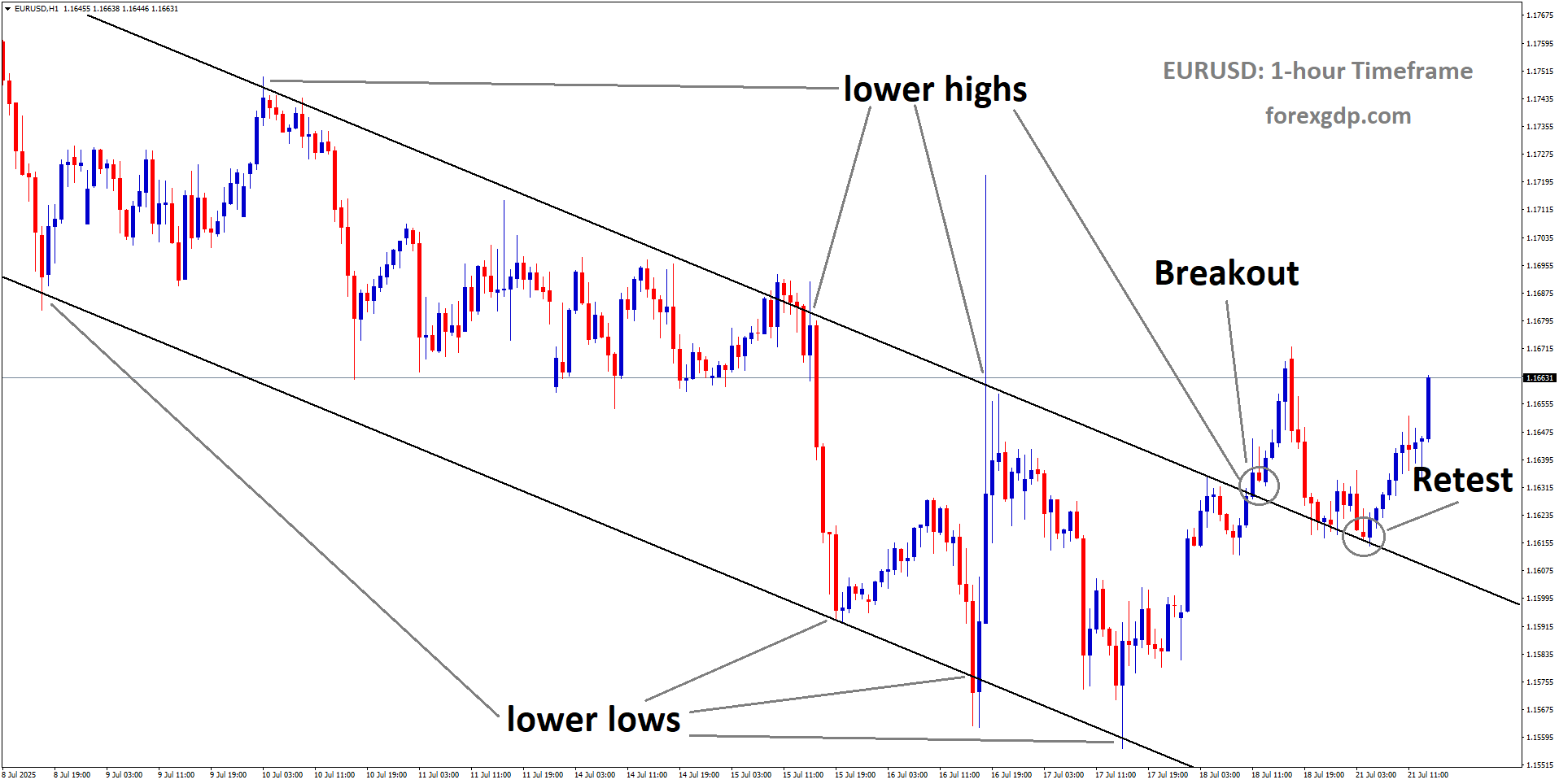
EURUSD is rebounding from the retest area of the broken downtrend channel
So, why all the fuss? It’s because President Trump has taken a harder line, pushing tariff rates up to 15%–20%. That’s not a small bump; it’s a significant escalation, especially when talks with the EU are still dragging on without any breakthrough. Both sides are watching each other closely, and no one wants to blink first.
Why Tariffs Are Causing So Much Drama
Tariffs are more than just economic jargon. They directly affect trade between nations, and in this case, they could impact everything from industrial goods to consumer electronics flowing between the U.S. and Europe. The European Union, not one to sit quietly, has hinted it’s prepping its own countermeasures—tariffs that could hit over 10% on American products.
This tit-for-tat tension brings back uncomfortable memories of trade wars from the past. Some even fear a repeat of what happened during the Great Depression, where trade barriers played a huge role in sinking economies. That’s why this isn’t just news for economists—it could ripple out and affect everyday consumers and businesses on both sides of the Atlantic.
What’s worse? Even if a deal is struck, there’s chatter that the EU might still go ahead with some retaliatory tariffs. So, even the best-case scenario might not be all that comforting.
The US Stance Is Complicated
On the U.S. side, there’s a bit of political drama playing out as well. Reports suggest that Treasury Secretary Scott Bessent has advised President Trump to steer clear of removing the Federal Reserve Chair, Jerome Powell. Apparently, there are concerns that making such a bold move could stir up economic uncertainty at a time when the markets are already on edge. For now, Powell stays, but the very fact that this issue is being talked about is telling.
Eyes on the ECB: What’s Next for the Eurozone?
As if the tariff news wasn’t enough, there’s another big event that could shift the Euro’s course—the European Central Bank’s (ECB) policy decision later this week. While no major changes in interest rates are expected, everyone is going to be listening very closely to what ECB President Christine Lagarde says. Her comments about the economy, inflation, and especially trade, could tip the scales.

Let’s be real here—central bank meetings are usually a bit dry, but this one matters. With trade talks in limbo and economic data offering mixed signals, the ECB’s tone could either give the Euro a push upward or leave it struggling to find support.
Will Tariffs Overshadow Earnings Season in the US?
Meanwhile, in the United States, investors have another reason to stay glued to the news: corporate earnings. Some of the biggest names in tech and defense—Alphabet, Tesla, Lockheed Martin, and General Dynamics—are all releasing their quarterly reports this week. These earnings could paint a clearer picture of how big companies are managing inflation, supply chain issues, and trade uncertainty.
Stronger-than-expected results might give the U.S. Dollar a temporary boost, but again, everything seems to be tied back to those looming tariffs. It’s all connected—investors are watching every move because one bad headline could change the game overnight.
How the Market Mood Reflects Consumer Sentiment
Now, let’s talk about how everyday people are feeling about the economy. The latest Consumer Sentiment Index out of Michigan showed a small but encouraging improvement. It ticked up to 61.8 from 60.7 the previous month, beating forecasts slightly. That’s not earth-shattering, but in an economy where perception often drives reality, it’s a good sign.
Also worth noting—expectations for future inflation have dropped, which suggests people aren’t as worried about prices spiking uncontrollably. When consumers feel better, they spend more. And when they spend more, it helps cushion any economic slowdown. So while this may seem like a small detail, it’s actually pretty important.
Final Summary: A Tense Wait as the Clock Ticks Down
As we head into the final stretch before August 1, there’s a lot up in the air. The Euro might have inched higher to start the week, but that’s more about cautious optimism than true momentum. Investors are caught between hope for a trade deal and fear of another economic scuffle between two of the world’s biggest players.
President Trump’s tough stance on tariffs has raised the stakes, and the EU’s potential retaliation only adds to the uncertainty. Meanwhile, the ECB’s upcoming announcement and U.S. earnings season are both wildcards that could either stabilize or shake the market even further.
For traders, investors, or anyone with an eye on global finance, this week is anything but boring. Whether you’re watching from the sidelines or deep in the action, one thing’s for sure—the next few days are going to be critical in shaping what comes next for the Euro and the broader global economy.
GBPUSD Holds Steady While Traders Await New US Tariff Signals
When it comes to currency movements, it’s not always about big swings or dramatic headlines. Sometimes, like now, it’s more about calmness in the storm. The British Pound Sterling (GBP) is one of the most widely followed currencies in the world, and currently, it’s moving in a narrow range against the US Dollar (USD). But why is it doing that? What’s really going on? Let’s dig into it — without all the complicated financial jargon.

GBPUSD is moving in an Ascending channel, and the market has reached a higher low area of the channel
What’s Keeping The Pound So Quiet Lately?
So, you might be wondering — why isn’t the Pound moving much?
Well, it’s because traders are basically waiting. They’re waiting for two big things:
-
Tariff Announcements from the US
-
What the Bank of England (BoE) might do next
There hasn’t been any explosive news lately that would push the Pound in either direction. That’s why things are so calm — for now.
The Tariff Drama: Why It Matters
Let’s talk about the US and tariffs. Recently, the US has been busy making trade deals — with the UK, Vietnam, Indonesia, and even a limited deal with China. But on the flip side, it’s also been pushing out tariffs on countries like Japan, Mexico, Canada, and the European Union.
Now here’s the interesting part: the US is trying to secure even more trade advantages, especially with Europe. Rumor has it they want tariffs of 15% to 20% on European imports. And they’re being stubborn about not lowering the 25% tariff on European cars.
Why does this matter? Because if the US and EU end up in a trade fight, it could hurt businesses on both sides of the Atlantic — including the UK, which, even post-Brexit, still has close economic ties with Europe. So, investors are holding their breath to see what happens next.
Is The Bank of England Going To Cut Rates? Probably Not Yet
For a while, there’s been a lot of talk about whether the Bank of England would cut interest rates again. But things are starting to shift.
Here’s what changed:
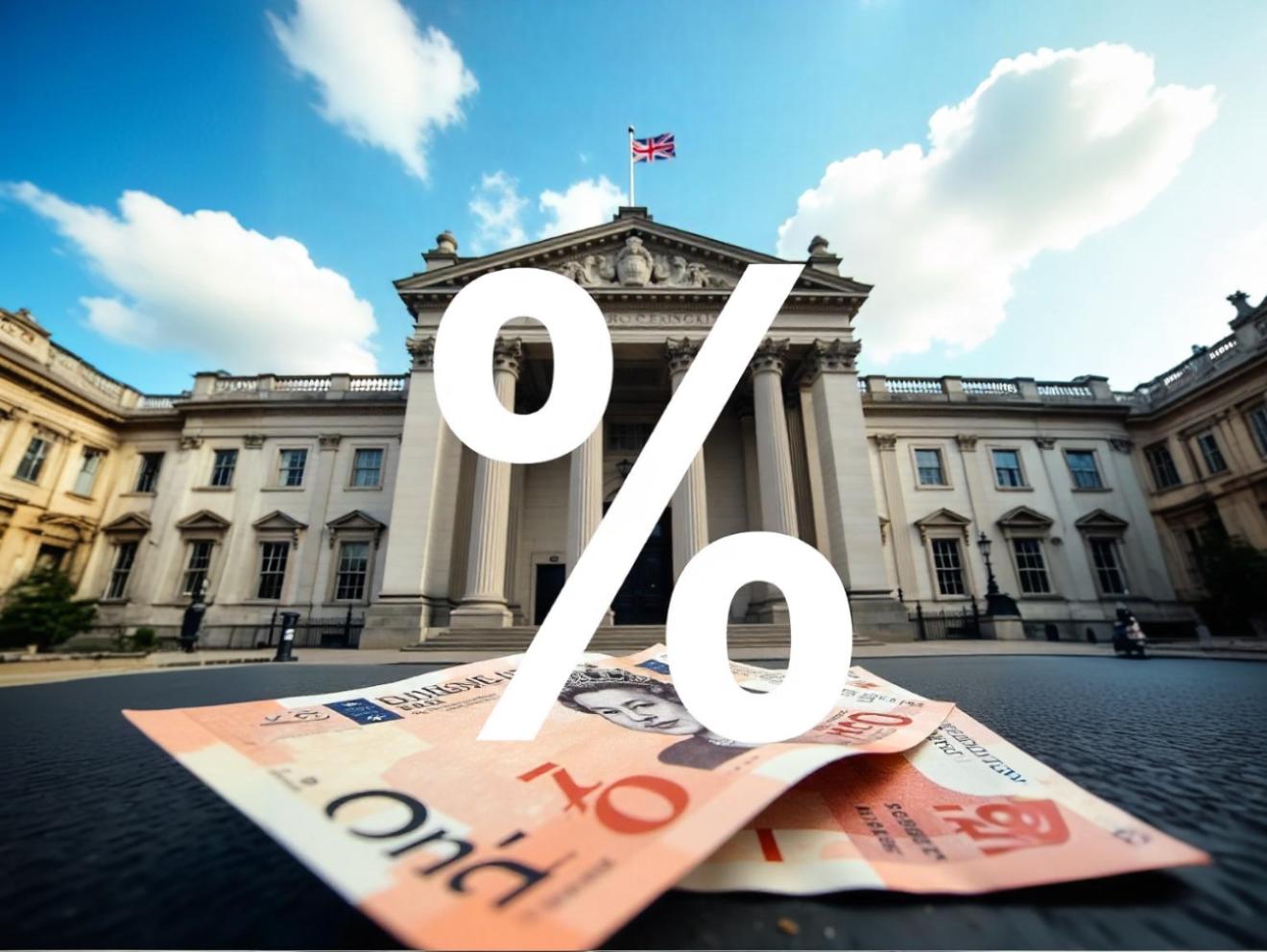
-
UK inflation came in hotter than expected — which means prices are rising faster than predicted.
-
The job market is looking better than feared — fewer people lost jobs than earlier estimates had shown.
This combo has made some major financial players — like Bank of America, Citigroup, Morgan Stanley, and Goldman Sachs — rethink their predictions. A few weeks ago, they were expecting a rate cut in September. Now? Not so much.
Some still believe the BoE might make cuts later in the year (maybe in November or December), but September looks less likely now.
That’s why the Pound isn’t falling. When people think interest rates might stay the same or even go up, it often gives the currency a bit more strength.
What About The US Dollar? Is It Still Strong?
Yep, the US Dollar is still standing tall. It recently came close to hitting a four-week high. Why? Because traders in the US are also changing their minds.
Just like in the UK, people thought the US Federal Reserve might cut interest rates in September. But after the latest inflation data came out, showing that some prices (especially on imported goods) are still rising, expectations have cooled.

GBPUSD is moving in an Ascending channel, and the market has reached a higher high area of the channel
Now, the chances of a US rate cut in September have dropped — from around 70% a month ago to less than 60% today.
So both central banks — the BoE and the Fed — are facing similar situations. Inflation is sticky. The job markets aren’t crumbling. And that’s why neither currency is moving much. They’re both kind of stuck in the same boat.
What’s Next On The Radar For The Pound?
There are a couple of important economic updates coming from the UK soon. Here’s what traders will be watching:
-
Retail Sales Numbers for June – These give a glimpse into how confident consumers are. Are people still spending despite rising prices?
-
Purchasing Managers’ Index (PMI) for July – This shows how businesses are feeling. Are they optimistic? Are they hiring more? Producing more?
If either of these comes in much stronger or weaker than expected, it could give the Pound a jolt in one direction.
But for now, things are pretty steady. And honestly, sometimes that’s a good thing in the world of currency trading.
Final Summary: Why The Calm Matters
Right now, the Pound isn’t making any wild moves — and that’s not a bad thing. It reflects a moment of balance between two powerful forces:
-
On one side, we’ve got stronger-than-expected UK data that’s making people second-guess the idea of rate cuts.
-
On the other side, there’s global uncertainty around US trade tariffs that’s putting pressure on all major currencies, not just the Pound.
So what does this mean for regular folks or casual investors? It’s a waiting game. Until there’s a major update — either from central banks or on the trade front — we’re likely to see more of this steady, range-bound behavior from the Pound.
If you’re someone who watches the currency markets or travels or does business internationally, this period of calm could be a great time to plan ahead. Just keep an eye on the calendar — especially around those upcoming UK economic reports and any trade news from Washington.

EURJPY is moving in Ascending channel and market has reached higher low area of the channel
In the world of forex, no movement can sometimes be just as meaningful as a big swing. It tells a story — and right now, that story is all about patience.
EURJPY Slides from Peak as Japan’s Election Results Stir Market Calm
When global politics shift, currencies feel the impact—and that’s exactly what happened to the Euro versus the Japanese Yen after Japan’s recent elections. If you’re wondering why the Euro suddenly dipped and what it could mean for the future, this article breaks it all down for you—no complicated charts, no technical jargon, just real insights.
Let’s explore what’s behind this currency move and what investors are watching next.
Japan’s Election Shake-Up: A Quick Recap
Japan’s recent elections created quite a stir—especially for currency markets. Here’s the deal: Prime Minister Ishiba’s ruling coalition didn’t do as well as expected. They lost their majority in the upper house—but just barely. In fact, they were short by only three seats.
That might sound like bad news, but for the financial world, it actually came as a bit of a relief.
Why Investors Breathed a Sigh of Relief
Even though Ishiba’s party technically lost the upper hand, the results weren’t a total disaster. Why? Because he still has a strong enough presence in the government to keep his position as Prime Minister—at least for now. And more importantly, it looks like he’ll be able to pass new laws by working with smaller, minority parties.
This kind of political continuity matters a lot. Investors love stability. They’d rather stick with the devil they know than roll the dice on a completely new direction. Ishiba staying in charge means fewer surprises on things like trade, taxes, and policy direction.
And here’s the big one: the opposition party—known for wanting lower taxes and possibly more aggressive changes—didn’t gain enough power to take over. That also means Japan is likely to stay on its current path when it comes to negotiating trade with the U.S., especially with an important deadline (August 1) coming up.
So, while it might not have been a perfect win for Ishiba, it was enough to keep markets calm—and even lift the Yen a little.
What Happened to the Euro? A Dip After a Long Climb
Now, let’s talk about the Euro. Leading up to the election, the EUR/JPY pair had been climbing for about six straight weeks. That’s a strong rally by any standard. But after the election results came out, the pair finally started to lose steam.

Think of it like running uphill for six weeks straight—eventually, even the strongest runners need a break. That’s what we’re seeing here: the Euro ran out of gas after a long sprint and started sliding back, especially once the Yen showed signs of strength.
The Japanese Yen’s gain is directly tied to the election result—it made investors more confident in Japan’s near-term political direction, and that makes the Yen more attractive.
So while the Euro didn’t crash dramatically, it definitely took a breather.
Behind the Scenes: Why Currencies React to Politics
You might be wondering, “Why do elections affect currencies in the first place?”
Great question.
Currencies react to more than just interest rates and inflation—they respond to uncertainty. And elections are a big source of that. When there’s a possibility of major policy changes, investors get nervous. They start moving their money into safer, more predictable places.
In this case, the Japanese Yen is seen as a “safe-haven” currency. That’s a fancy way of saying investors trust it during uncertain times. So when the political picture in Japan turned out to be more stable than feared, the Yen gained strength.
On the flip side, the Euro didn’t have any big news to support it. It was already riding high from weeks of gains, so when the Yen started to climb, the Euro naturally dipped.
So, What’s Next for the EUR/JPY Pair?
While we can’t predict the future, we can take a guess at what traders might focus on next.
-
Political Developments in Japan: If Prime Minister Ishiba can keep the support of minority parties and continue to govern smoothly, the Yen may stay strong.
-
Trade Talks with the U.S.: The August 1 deadline for trade negotiations could cause more movement. If Japan reaches a deal with the U.S., that might further support the Yen.
-
Eurozone News: Any major developments out of Europe—whether political, economic, or otherwise—could help push the Euro up or down. But for now, there’s no major news lifting the Euro on its own.
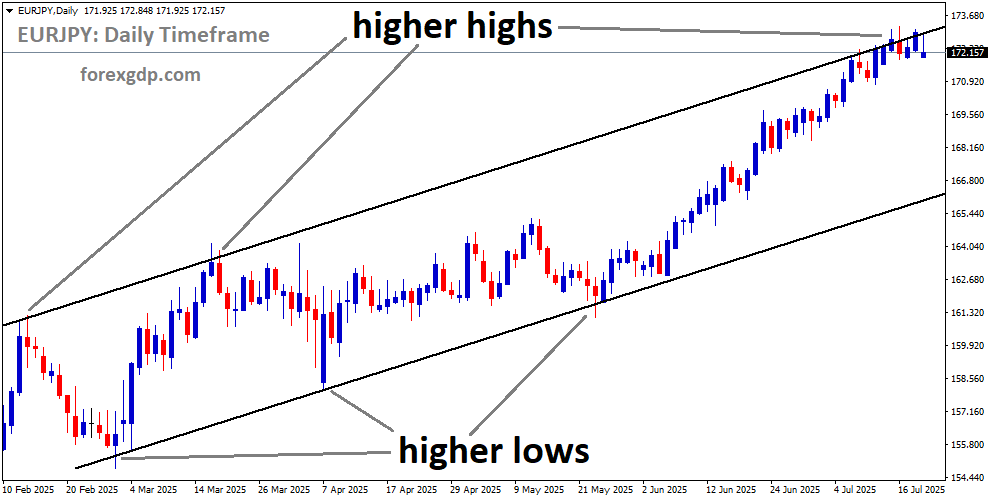
EURJPY is moving in an Ascending channel, and the market has reached a higher high area of the channel
It’s a bit of a tug-of-war: the Euro needs fresh fuel to climb again, while the Yen is gaining ground on political reassurance.
Final Thoughts: It’s All About Confidence and Calm
In the end, the recent dip in the Euro against the Yen wasn’t about a sudden disaster—it was about a return to calm.
Markets had braced for more chaos from Japan’s elections, but when the results came in, things looked a lot steadier than feared. That gave the Yen a boost and pushed the Euro down a bit after a strong run.
If you’re watching this currency pair, keep your eye on the political situation in Japan, trade talks with the U.S., and any new stories coming out of Europe. Because in the world of forex, it’s not just about charts and numbers—it’s about stories, stability, and staying ahead of what might happen next.
GBPJPY Edges Higher as LDP’s Election Setback Fuels Market Uncertainty
When we look at currency pairs like GBP/JPY, there’s always more going on beneath the surface than just numbers ticking on a screen. Behind every movement is a story — a mix of politics, economic shifts, and market expectations. Right now, this pair is in the spotlight, not just because of rate talk in the UK, but due to some big political drama unfolding in Japan.

GBPJPY is moving in an Ascending channel, and the market has fallen from the higher high area of the channel
Let’s unpack all the juicy details, in simple language, without diving into any complicated technical charts or jargon.
Japan’s Political Drama: Calm on the Surface, But Turbulent Underneath
It’s no secret that Japan has been navigating some choppy political waters lately. The big news? Prime Minister Shigeru Ishiba is sticking around even though his party — the ruling Liberal Democratic Party (LDP) — just lost its majority in Japan’s upper house elections.
So, What Does That Mean for the Japanese Yen?
You might think a loss like that would shake things up badly. But Ishiba’s decision to stay in office has actually brought a bit of political stability, at least for now. People were bracing for chaos or even a resignation, but that didn’t happen. That steadiness helped the Yen hold its ground — at least temporarily.
But here’s the twist: Japan’s opposition parties are itching to spend more. They’re pushing for a wave of government spending and even tax cuts. Sounds nice on paper, right? But that kind of fiscal stimulus can actually weaken the Yen in the long run. Why? Because more spending and lower taxes often mean borrowing more — which can scare off investors who don’t want to see inflation rise or bond yields spike.
Ishiba himself has criticized these ideas, saying they’d take too long to kick in. He wants quicker fixes to help struggling households, which shows he’s aware of the pressures but not ready to take the opposition’s route. And don’t forget — he’s still partnering with Komeito to keep the coalition government running.
Trade Talk With the US: A Balancing Act
While dealing with domestic political tension, Ishiba is also trying to keep international ties strong, especially with the United States. He recently mentioned his interest in hashing out a trade deal with President Trump, one that could ease tariffs while still protecting Japan’s national interests.
Now, you might be wondering: What does this have to do with GBP/JPY? Good question. Japan’s relationship with the U.S. can influence how investors see the Yen — especially if trade talks promise more exports, which could strengthen the Yen. But uncertainty or failed negotiations? That could send it sliding.
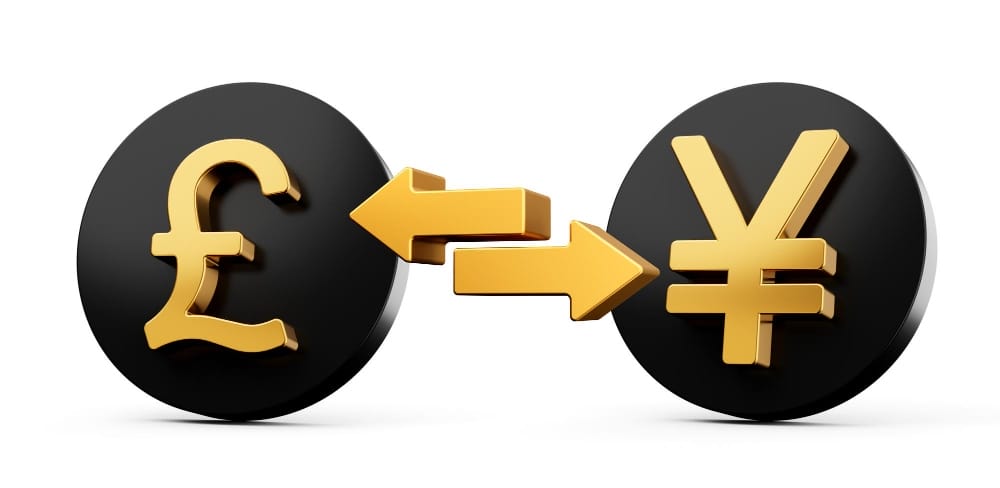
What’s Happening in the UK: BoE Throws a Curveball
Switching gears to the UK — the Pound has been feeling a bit lighter lately. And that’s not necessarily a bad thing.
Here’s what’s up: The Bank of England (BoE) was expected to cut interest rates multiple times in 2025. But now? That seems less likely. Several big financial firms on Wall Street have changed their predictions after seeing hotter-than-expected inflation numbers for June and surprisingly sturdy labor market data through May.
Put simply: the UK economy isn’t slowing down as quickly as people thought. That means the BoE might not need to slash rates aggressively, which is good news for the Pound. Higher interest rates generally attract more investors looking for better returns — so this fresh outlook gave GBP a bit of a boost.
When GBP edges higher and JPY is under pressure due to internal issues and possible fiscal loosening, it naturally gives the GBP/JPY pair upward momentum. But it’s not all smooth sailing.
Why This Momentum Might Not Last
Even though GBP/JPY has gained some ground lately, there are still a lot of moving parts that could put the brakes on its rise.
First, Japan’s political environment, while seemingly stable, is still under pressure. Any shift in the coalition, or if Ishiba suddenly loses support, could cause sudden shocks.
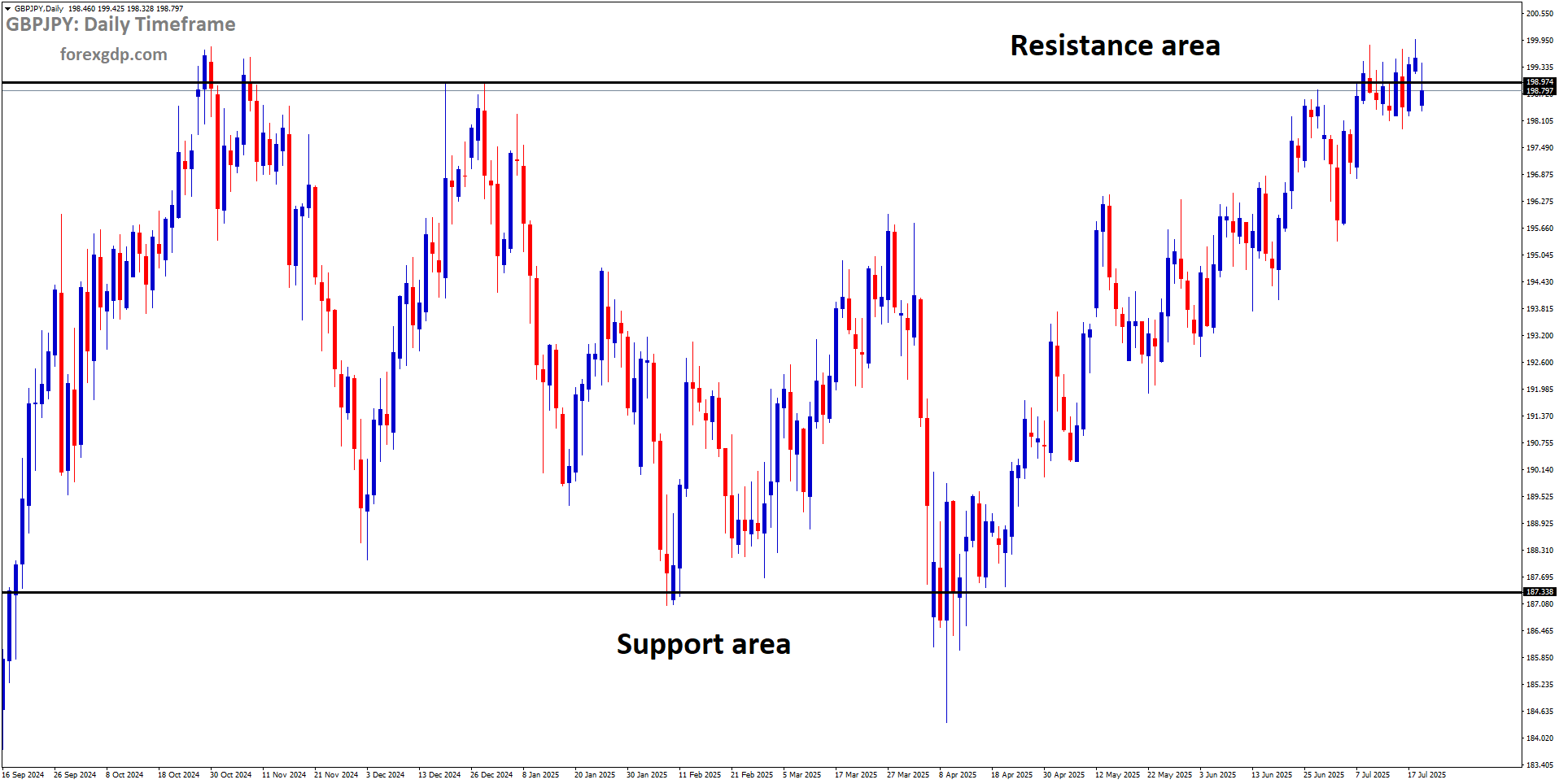
GBPJPY is moving in a box pattern, and the market has reached the resistance area of the pattern
Second, while the UK may not see multiple rate cuts now, that doesn’t mean cuts are totally off the table. Inflation is still unpredictable. One month of strong data doesn’t equal long-term certainty. If future reports show economic weakness or inflation cooling off faster, the BoE could change its stance again. And that would take the wind out of GBP’s sails.
Lastly, global factors like trade tensions, geopolitical risks, or unexpected economic data from major countries can sway both currencies quickly. So even if GBP/JPY looks bullish now, it’s walking a tightrope.
Final Summary: A Tug of War Between Two Uncertainties
Right now, GBP/JPY is caught in a dance between two very different forces. On one side, the UK Pound is gaining support as the fear of rapid interest rate cuts fades away. On the other side, the Japanese Yen is holding steady but facing political heat and opposition pressure that could change the game completely if spending policies are pushed through.
If you’re watching this currency pair closely, it’s not just about where it’s trading now. It’s about staying tuned to the deeper stories — leadership decisions in Japan, economic signals in the UK, and how global players are reacting to both.
The world of forex isn’t just about numbers. It’s about narratives. And right now, GBP/JPY is telling a pretty compelling one. Let’s see how the next chapter unfolds.
Don’t trade all the time, trade forex only at the confirmed trade setups
Get more confirmed trade signals at premium or supreme – Click here to get more signals, 2200%, 800% growth in Real Live USD trading account of our users – click here to see , or If you want to get FREE Trial signals, You can Join FREE Signals Now!


